The proper use of technology enables businesses to be more efficient. Our recent research into technology for business innovation found that 56 percent indicate innovative technology is very important, yet only 9 percent are very satisfied with theirs, showing plenty of room for improvement. As we enter 2013, businesses have more choices than ever for technology to improve business and IT. Our firm has identified six key technologies that give organizations significant competitive advantages: big data, business analytics, business and social collaboration, cloud computing, mobile technology and social media. Our research agenda for 2013 is designed to help organizations assess and analyze these technologies and make the best possible decisions.
Big Data
Big data helps business and IT organizations manage and use information. Our technology innovation research finds only 14 percent of businesses today are very satisfied with their existing big data technology. At the same time, organizations that utilize big data 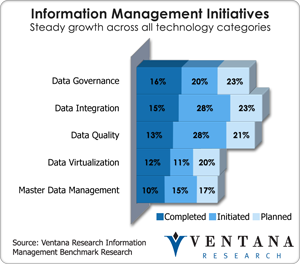 effectively have improved their business significantly, according to 28 percent of organizations. Our research in 2013 will build on our assessment of big data in 2012. We will do a benchmark research study on big data analytics and another on information optimization. We see that organizations are investing in information assets that require big data and the analytics associated with it to refine information and optimize business activities. Big data can have significant business value, but using it requires that IT coordinate with business on the benefits they can achieve. Making a business case for an investment in big data technology can help organizations address the top issue of it being too expensive, as found in almost half (44%) of organizations. At the same time, organizations need to ensure they have the competencies to meet big data needs, which include not just the technology for storage and access but also underlying information management issues such as data governance, data integration and data quality, which our research in 2012 found are still in embryonic form in most organizations.
effectively have improved their business significantly, according to 28 percent of organizations. Our research in 2013 will build on our assessment of big data in 2012. We will do a benchmark research study on big data analytics and another on information optimization. We see that organizations are investing in information assets that require big data and the analytics associated with it to refine information and optimize business activities. Big data can have significant business value, but using it requires that IT coordinate with business on the benefits they can achieve. Making a business case for an investment in big data technology can help organizations address the top issue of it being too expensive, as found in almost half (44%) of organizations. At the same time, organizations need to ensure they have the competencies to meet big data needs, which include not just the technology for storage and access but also underlying information management issues such as data governance, data integration and data quality, which our research in 2012 found are still in embryonic form in most organizations.
Business Analytics
Our recent research on technology innovation found business analytics to be the top-ranked priority, and very important to more than half (52%) of organizations. Business analytics is not just a technology to get metrics faster but a set of processes to operate smarter with information, to better visualize and apply advanced methods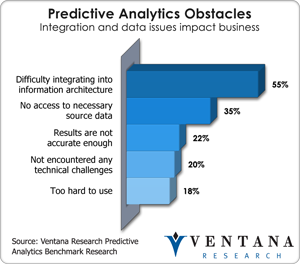 such as predictive analytics, and to identify ways to better search and present information for a broad range of business constituents. Our research finds only half (51%) of organizations are satisfied with their existing processes due to lack of skilled resources. More than half of organizations say analytics are too hard to build and maintain or data is not readily available. The most time-consuming aspects of the process are data-related ones, according to 44 percent of organizations. The technology too still has room to improve, with only 20 percent being very satisfied. The most critical capabilities are in the areas of predictive analytics (49%), visual discovery (48%) and taking action on the outcomes of the analytics (46%). We also found in our next-generation business intelligence research that the use of mobile technologies such as tablets is growing across organizations. We also found in our research a high priority to use social collaboration technology with business analytics to work together on making improvements in shorter period of time than traditional email or phone calls. Our research agenda in 2013 will investigate big data analytics and next-generation business analytics approaches building on top of our research on predictive analytics, which found that organizations still struggle to integrate predictive analytics with information architectures to support analysts and data scientists. Advancing the competencies and focusing on analytics are critical processes, but businesses also need simpler communication of results to help those responsible understand situations and consider potential recommendation actions. We hope that technology suppliers will work to better align to the human dynamics of what really happens with analytics to better support communicating observations and insights to ensure that end goals are achieved.
such as predictive analytics, and to identify ways to better search and present information for a broad range of business constituents. Our research finds only half (51%) of organizations are satisfied with their existing processes due to lack of skilled resources. More than half of organizations say analytics are too hard to build and maintain or data is not readily available. The most time-consuming aspects of the process are data-related ones, according to 44 percent of organizations. The technology too still has room to improve, with only 20 percent being very satisfied. The most critical capabilities are in the areas of predictive analytics (49%), visual discovery (48%) and taking action on the outcomes of the analytics (46%). We also found in our next-generation business intelligence research that the use of mobile technologies such as tablets is growing across organizations. We also found in our research a high priority to use social collaboration technology with business analytics to work together on making improvements in shorter period of time than traditional email or phone calls. Our research agenda in 2013 will investigate big data analytics and next-generation business analytics approaches building on top of our research on predictive analytics, which found that organizations still struggle to integrate predictive analytics with information architectures to support analysts and data scientists. Advancing the competencies and focusing on analytics are critical processes, but businesses also need simpler communication of results to help those responsible understand situations and consider potential recommendation actions. We hope that technology suppliers will work to better align to the human dynamics of what really happens with analytics to better support communicating observations and insights to ensure that end goals are achieved.
Business and Social Collaboration
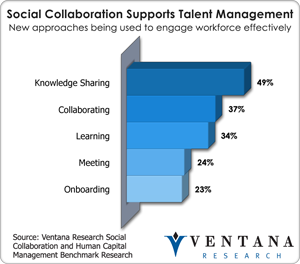 The revolution in social media has expanded into business, bringing with it social collaboration and helping business processes by connecting people to achieve goals personally, departmentally or across an organization. This new technology was ranked the second most important technology in our research, but only 17 percent of organizations are very confident in their ability to use the technology well. With most organizations (86%) using shared folders and documents, it should be no surprise that part of the issue is related to technology. Organizations are evaluating new methods such as wall posting (45%), social recognition (41%), earning badges and awards (40%) and broadcast or Twitter-like capabilities (39%). With only a quarter of organizations being satisfied with their existing approaches, we see a lot of changes coming in 2013 in regards to the technologies selected and deployed. Our research in 2013 will examine where collaboration is critical in areas of human capital management, sales, customer engagement and even finance. Building on top of some groundbreaking research across business and vertical industries, we see business advancing rapidly with or without IT support, since business and social collaboration can be easily onboarded through the use of cloud computing. Unfortunately organizations are mixed in the methods they prefer to use to access collaboration – embedded in applications, through Microsoft Office, embedded within tools like business intelligence or stand-alone – making it complex to have consistency for users and their interactions. Using social collaboration with business analytics is a growing priority and organizations will need to assess their technologies to see if they meet this need. We believe that social collaboration will help bridge generational divides between workers as it becomes more easily accessible through web and mobile technologies, allowing managers and workers to engage anytime or anyplace. Focusing on the benefits of social collaboration, such as knowledge sharing, is critical as our research finds as the top need in 49 percent of organizations.
The revolution in social media has expanded into business, bringing with it social collaboration and helping business processes by connecting people to achieve goals personally, departmentally or across an organization. This new technology was ranked the second most important technology in our research, but only 17 percent of organizations are very confident in their ability to use the technology well. With most organizations (86%) using shared folders and documents, it should be no surprise that part of the issue is related to technology. Organizations are evaluating new methods such as wall posting (45%), social recognition (41%), earning badges and awards (40%) and broadcast or Twitter-like capabilities (39%). With only a quarter of organizations being satisfied with their existing approaches, we see a lot of changes coming in 2013 in regards to the technologies selected and deployed. Our research in 2013 will examine where collaboration is critical in areas of human capital management, sales, customer engagement and even finance. Building on top of some groundbreaking research across business and vertical industries, we see business advancing rapidly with or without IT support, since business and social collaboration can be easily onboarded through the use of cloud computing. Unfortunately organizations are mixed in the methods they prefer to use to access collaboration – embedded in applications, through Microsoft Office, embedded within tools like business intelligence or stand-alone – making it complex to have consistency for users and their interactions. Using social collaboration with business analytics is a growing priority and organizations will need to assess their technologies to see if they meet this need. We believe that social collaboration will help bridge generational divides between workers as it becomes more easily accessible through web and mobile technologies, allowing managers and workers to engage anytime or anyplace. Focusing on the benefits of social collaboration, such as knowledge sharing, is critical as our research finds as the top need in 49 percent of organizations.
Cloud Computing
Our research finds that businesses don’t see cloud computing as innovative technology but rather as a utility and becoming a standard method that can be easily accessed and leveraged as part of their portfolio of computing options. These faster methods to onboard applications have become easy and in most cases require little IT involvement. But beyond the simplicity for business and potential chaos for IT to eventually govern and support, the cloud computing environment is now a viable platform for IT to leverage in a multitude of methods, from IT infrastructure to developing and operating applications. The cloud computing environment can be used as a central point for integrating data and storing it for the enterprise or for customers and suppliers, but most organizations have not automated the integration of data to support business processes or business analytics and decision support. The lack of automation has increased concerns for data security, which 63 percent of organizations in our data in the cloud research find to be a major concern. In all of our research in 2012, the preference for cloud computing is growing across lines of business and especially in areas like sales, customer service and human capital management. In 2013 we plan to further assess the advancements in cloud computing, from big data and analytics to information that can be leveraged from a broad range of applications and services.
But beyond the simplicity for business and potential chaos for IT to eventually govern and support, the cloud computing environment is now a viable platform for IT to leverage in a multitude of methods, from IT infrastructure to developing and operating applications. The cloud computing environment can be used as a central point for integrating data and storing it for the enterprise or for customers and suppliers, but most organizations have not automated the integration of data to support business processes or business analytics and decision support. The lack of automation has increased concerns for data security, which 63 percent of organizations in our data in the cloud research find to be a major concern. In all of our research in 2012, the preference for cloud computing is growing across lines of business and especially in areas like sales, customer service and human capital management. In 2013 we plan to further assess the advancements in cloud computing, from big data and analytics to information that can be leveraged from a broad range of applications and services.
Mobile Technology
The use of smartphones and tablets has become common among consumers who are also workers in organizations. Mobile technology is a new platform on which organizations can deploy applications and tools for a wide array of business needs. Yet our next-generation 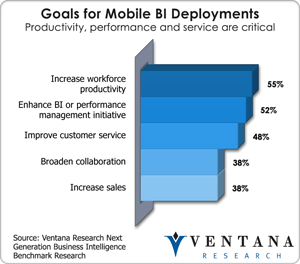 workforce management research finds only 8 percent of organizations indicate they have everything they need on these technologies, and only a quarter more indicate they have most but not all they need available, which leaves a large number of organizations not able to meet their mobile business needs. This might be why only 20 percent are very confident in their use of mobile technology today. The debate on whether to use native applications and tools or operate across a web browser environment still looms, with native (39%) outpacing browser (33%) and a fifth having no preference. Bring your own device (BYOD) is another area of friction, where 39 percent of organizations allow this approach with smartphones and 45 percent with tablets. Organizations have many opportunities to determine how to use mobile technology effectively, and can derive many benefits. Our next-generation business intelligence research found increased workforce productivity was at the top of the list in 55 percent of organizations. Our research in 2013 will further investigate the use of tablets across the line of business, since this was found to have the largest growth planned (34%), while smartphones are more established.
workforce management research finds only 8 percent of organizations indicate they have everything they need on these technologies, and only a quarter more indicate they have most but not all they need available, which leaves a large number of organizations not able to meet their mobile business needs. This might be why only 20 percent are very confident in their use of mobile technology today. The debate on whether to use native applications and tools or operate across a web browser environment still looms, with native (39%) outpacing browser (33%) and a fifth having no preference. Bring your own device (BYOD) is another area of friction, where 39 percent of organizations allow this approach with smartphones and 45 percent with tablets. Organizations have many opportunities to determine how to use mobile technology effectively, and can derive many benefits. Our next-generation business intelligence research found increased workforce productivity was at the top of the list in 55 percent of organizations. Our research in 2013 will further investigate the use of tablets across the line of business, since this was found to have the largest growth planned (34%), while smartphones are more established.
Social Media
Social media is a new path for organizations to use to expand their corporate footprint to a broader audience and to gain brand awareness by marketing products and services. This new channel of opportunity enables organizations to rethink how they operate many of their business processes, including the ones that they use to find new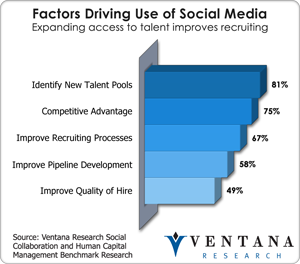 talent and track candidates into an organization. In 2012 our research into social media and recruiting found that only 7 percent of organizations are very confident in use of this channel, but half of organizations are planning to change how they use social media over the next year; for instance, 81 percent of organizations have identified it as a method to identify new talent pools. In 2013 we will continue to examine best practices and benefits of investments in this channel. We will also assess social media as a new channel for customers to engage with organizations through a new benchmark in next-generation customer engagement. Our research in 2012 found organizations benefit from using this channel to handle a broad range of customer questions and issues.
talent and track candidates into an organization. In 2012 our research into social media and recruiting found that only 7 percent of organizations are very confident in use of this channel, but half of organizations are planning to change how they use social media over the next year; for instance, 81 percent of organizations have identified it as a method to identify new talent pools. In 2013 we will continue to examine best practices and benefits of investments in this channel. We will also assess social media as a new channel for customers to engage with organizations through a new benchmark in next-generation customer engagement. Our research in 2012 found organizations benefit from using this channel to handle a broad range of customer questions and issues.
While new technologies can help business innovate, what’s old is still new, and requires a foundation of skills and resources. For example, with big data, those organizations that have information management competencies to automate big data efforts will find themselves further ahead, as they leverage the core skills of data integration to handle more data environments. Those organizations that use business and social collaboration to connect people and processes more efficiently than conference calls and email will better leverage their human capital investments.
At the same time new techniques can make it simpler to gain value from existing technology investments, such as advancements in the use of text to present analytics in a readable form, new methods to use visualization as a discovery tool on analytics, and the ability to engage employees by using new and more social collaborative methods. Taking advantage of this technology requires smart use of best practices, leadership from the top and agreement about the desired outcome. Organizations need to have technology in place to develop a business case with balanced evaluation criteria that are not about the vision a vendor has but rather about what the vendor can provide to advance business efforts. We use this practical approach in our vendor and product assessment methodology and rating called the Value Index which we will be assessing over 100 vendors in 2013.
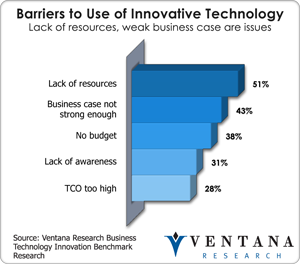 Organizations should explore resources in the company to determine if necessary skill sets exist, since their lack is the top barrier to adoption of technology according to 51 percent of organizations as found in our research. Part of this process is ability to know whether the technology can adapt to the workers’ needs and capabilities, and whether it requires weeks of training. Organizations should also look to the future and examine how to use cloud computing to rent technology, and how to use mobile technology to enhance collaboration. They should also keep pace with peers and competitors through the use of benchmarks and industry comparisons.
Organizations should explore resources in the company to determine if necessary skill sets exist, since their lack is the top barrier to adoption of technology according to 51 percent of organizations as found in our research. Part of this process is ability to know whether the technology can adapt to the workers’ needs and capabilities, and whether it requires weeks of training. Organizations should also look to the future and examine how to use cloud computing to rent technology, and how to use mobile technology to enhance collaboration. They should also keep pace with peers and competitors through the use of benchmarks and industry comparisons.
You can depend on Ventana Research to provide sound facts and pragmatic guidance to help you leverage technology to gain a competitive advantage in your business and innovate in your processes and with your workforce.
Read 2013 Research Agenda
Regards,
Mark Smith
CEO and Chief Research Officer


















